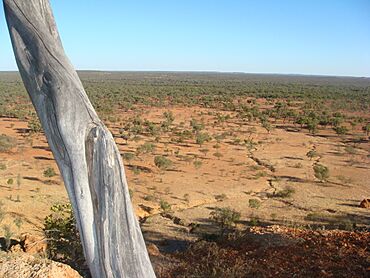Yowah facts for kids
Quick facts for kids YowahQueensland |
|||||||||||||||
|---|---|---|---|---|---|---|---|---|---|---|---|---|---|---|---|

Yowah landscape, 2008
|
|||||||||||||||
| Population | 126 (2021 census) | ||||||||||||||
| • Density | 0.04331/km2 (0.1122/sq mi) | ||||||||||||||
| Postcode(s) | 4490 | ||||||||||||||
| Area | 2,909.5 km2 (1,123.4 sq mi) | ||||||||||||||
| Time zone | AEST (UTC+10:00) | ||||||||||||||
| LGA(s) | Shire of Paroo | ||||||||||||||
| State electorate(s) | Warrego | ||||||||||||||
| Federal Division(s) | Maranoa | ||||||||||||||
|
|||||||||||||||
Yowah is a small town located in the outback of Queensland, Australia. It's famous for its unique opals, especially a special kind called the "Yowah nut". In 2021, about 126 people lived in Yowah. This town is a great place to learn about opal mining and enjoy the quiet outback life.
Contents
Discovering Yowah's Location
Yowah is in western Queensland. It is about 938 kilometers (583 miles) west of Brisbane, the capital city of Queensland. It is also about 132 kilometers (82 miles) west of Cunnamulla.
You can reach Yowah by a sealed road. If you are driving at night, be careful! There can be many animals on the road.
A Glimpse into Yowah's Past
Early Days and Opal Discoveries
The Yowah area began as a large farming property called Yowah pastoral station in the mid-1860s. The first opal fields were found here, and opal mining has been very important to the town ever since.
Growing Community and Services
Many visitors come to Yowah during the cooler winter months. They enjoy the nice weather and the friendly welcome from the town.
A small school, Yowah State School, opened in 1998. It was one of the smallest schools in Queensland, with only three students in 2012. The school closed in 2017 because there were not enough students.
In 2014, the town built two special spas. These spas use warm water from deep underground.
Yowah's Population Over Time
The number of people living in Yowah has changed over the years:
- In 2006, there were 142 people.
- In 2016, the population was 141 people.
- In 2021, about 126 people lived in Yowah.
Learning in Yowah
There are no schools directly in Yowah or very close by. Students in Yowah can learn through distance education, which means they study from home. Some students might also go to boarding schools in other towns.
Town Facilities and Services
Yowah has several useful facilities for its residents and visitors:
- The Paroo Shire Council runs a Rural Transaction Centre. This center has a tourist information desk, a public library, a cafe, and internet access.
- There is a caravan park where people can stay.
- A general store sells groceries and fuel, and it has an ATM.
- The town has a public hall. This hall hosts activities like craft groups, indoor bowls, and meals with a bar two nights a week.
- During winter, the caravan park holds a weekly dinner and a "duck race" to raise money for groups like the State Emergency Service (SES) and the Rural Fire Service.
- Yowah has two airfield runways that can be lit up at night.
- The town gets its water from natural underground pressure, which is safe to drink.
Exciting Events in Yowah
Yowah Opal Festival
The Yowah Opal Festival is a big event held every year on the third weekend in July. It celebrates opal mining in the area. You can see and buy opals, enjoy exhibitions, and find nightly entertainment.
Fun Things to Do in Yowah
Opal Hunting and Heritage Trails
- Fossicking Area: Yowah has a free area where you can try "fossicking" for opals. Fossicking means searching for minerals. You can get a special license for it at the general store.
- Heritage Trail: You can explore the areas around Yowah by following a heritage trail. This trail helps you discover the history of the region.
Relaxing at the Artesian Spas
Yowah has community-run artesian spas. These are two baths filled with warm water from deep underground, heated naturally to about 57°C (134.6°F). The water comes from the Great Artesian Basin, which is also the town's main source of drinking water. There is also a free camping area with toilets, showers, and laundry facilities.




